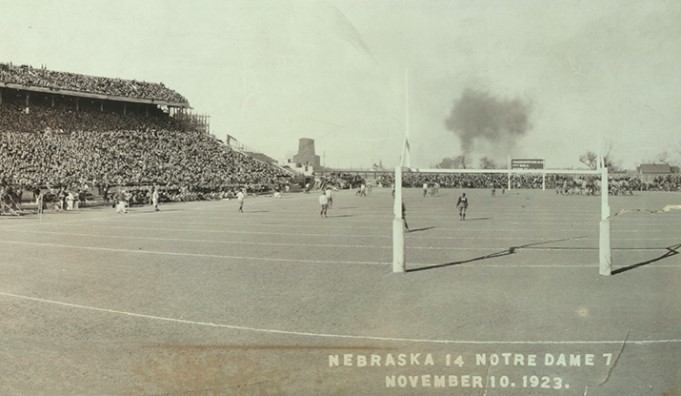|
Football Short Story
"Beat the Papists"
Out of Bounds: An Anecdotal History of Notre Dame Football,
Michael Bonifer and L. G. Weaver (1978) Some of Notre Dame's longest afternoons were spent in Lincoln, Nebraska. Not that a weekend in Lincoln is any carnival today, mind you, but in the Nebraska Cornhuskers, Rockne's Ramblers had a special bugbear. The Huskers had more success against Rockne than any other school, winning three and tying one in eight encounters. Part of the success was simply due to solid football playing; part of it came because of the home field hurdles flung into Notre Dame's path.
A persistent anti-Catholic specter would rear its head when Notre Dame played in Lincoln. Incited by newspaper headlines such as "Horrible Hibernians Invade Today!", students and townsfolk would cluster outside the hotel where the horribles were staying and caterwaul through the night. Banners urging the Cornhuskers to "Beat the Papists" and "Maul the Mackerel-Snappers" saluted the visitors when they walked onto the field.
Invariably, a few of the Nebraska gridders would carry the religious clash into the game. Notre Damers wore medals and scapulars while in uniform, and in the pile-up following a play, Husker hands would go for them and try to make the visitors literally choke under pressure. More than one Rambler had his chain yanked noose-tight around his neck. Insults zinged back and forth, escalating into questions of ancestry. And from there into physical rebuttal. After being prodded over the brink, Hunk Anderson growled at one Nebraskan, "I'm not Catholic, but I'm gonna get your Protestant ass anyway!"
 While the ill feelings over religion were an annoying sidelight, they had no real weight in the final score. Nebraska found the key to shackling Notre Dame's speed. That was the difference.
The Cornhusker players fit a general profile: they were tall, strong country boys (as folklore has it, they got their strength by hoisting a newborn calf overhead and repeating the exercise daily until the animal was a full-grown 1200 pound steer); and most of them were slower than an arthritic mule. On a fast track, the Notre Dame backfield could go over, under and around the Nebraska line. No problem. The Huskers called on a little native farming talent, and some good old-fashioned gamesmanship. They doctored their field, slowing down the Irish, giving their big linemen time to lumber in and swat down runners with a calloused paw.
The 1923 game was played on a field of dirt that had been plowed and rolled—but not rolled much. It was unsure footing at best. Every time a Notre Dame back tried to cut upfield, his footing gave way like he'd stepped on a pile of marbles. That's the way the gridiron—and the season—crumbled. The Irish suffered their only loss of the year, 14-7.
Two years later, the resourceful Nebraska groundskeeper—and presumably an agriculture student who was encouraged to use the field for lab work—let the grass grow to a height of four inches. "Are we going to play football on it or make it into hay?" asked Rockne. Again the Irish speed was ineffectual. Again the Cornhuskers triumphed, 17-0.
|